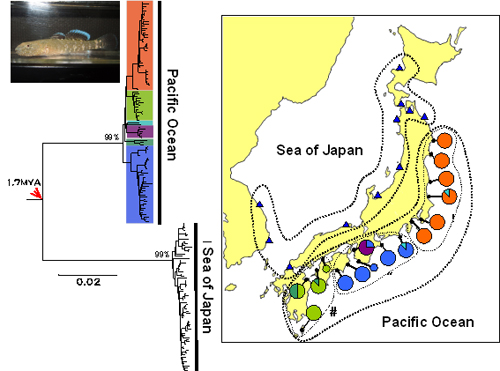RESEARCH
Our research interests include
- Population genetic structure and phylogeography of marine and freshwater organisms (Example 1)
- Genetic management of commercially important species in marine and freshwater (Example 2)
- Breeding of shellfish and sea cucumber to establish new strains (Example 3)
- Conservation genetics of endangered fish species
- Ballast water management to reduce the risk of biological invasion (Example 4)
- Wildlife forensics
- Traceability of fish or shellfish and the products

| Example 1. | We examined the phylogeography of the common Japanese intertidal goby Chaenogobius annularis using the mitochondrial cytochrome b gene, the NADH dehydrogenase subunit 2 gene, and the surrounding transfer RNA from 195 specimens collected in 27 localities around the Japanese Archipelago and the Korean Peninsula, and reconstructed the historical processes of its current distribution. In total, 169 unique haplotypes were obtained, and phylogenetic trees showed two genetically distinct lineages: the Pacific Ocean and the Sea of Japan lineages, whose divergence was estimated to have occurred in the early Pleistocene, related to the paleoenvironmental history of the Sea of Japan. After the divergence, the Sea of Japan lineage rapidly attained its current distribution, whereas the present-day distribution of the Pacific Ocean lineage was formed as a result of vicariance and dispersal(Hirase et al., 2012). |

| Example 2. | Japanese flounder Paralichthys olivaceus is one of the most important fishes in Japanese coastal fisheries. Overharvesting has caused a reduction of the abundance. For the stock enhancement, numerous juveniles have been produced at hatcheries and stocked to the ocean. But the ecology of stocked fish, especially, degree of reproductive contribution to the natural resources is still unknown. We are trying to elucidate behavior and reproductive fitness of stocked Japanese flounder using microsatellite and mitochondrial DNA markers with high resolution for the individuals and parentages. |

| Example 3. | The genetic relationship among the three color variants (Red, Green and Black) of the Japanese sea cucumber, Sticopus japonicus, was investigated using 11 microsatellite markers. Genetic differentiation testing among the three sympatric color types showed the strong heterogeneity between Red and others, while no significant difference between Green and Black. UPGMA trees constructed from 10 sample populations from five localities showed two distinct clusters (Red, Green and Black). These results suggest that the Red is reproductively isolated from other types, and Green and Black are color polymorphism within a species (Kanno et al., 2006). This genetic information would be useful for breeding and stock enhancement programs of the sea cucumber. |

| Example 4. | Ballast water discharged from ships is the most important vector for the introduction and transfer of invasive aquatic species. Treatment methods except for the exchange of ballast water or using toxic chemicals could be effective in reducing the risk of invasions while posing no danger to the environment. We challenge to develop novel ballast water treatment using micro-nano babble. Photo is the experimental plant including micro-nano babble generator. |
